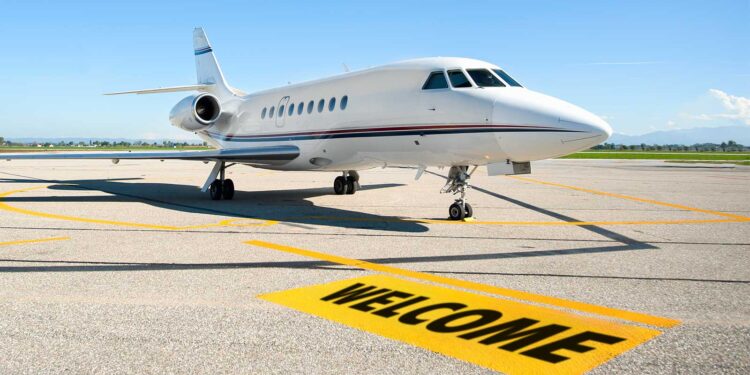Operating to Japan – Part 2: Permits, Slots & CIQ

This is a post by author Hiroshi Higashiyama. Hiroshi is representative director for Universal Aviation Japan, which has aircraft ground handling facilities in Haneda, Narita, Sapporo, and Osaka. Hiroshi is an expert on business aircraft operations in Japan and can be contacted at hiroshihigashiyama@universalaviation.aero.
This business aviation blog post continues from our article last week, entitled “Operating to Japan – Part 1: Airports & Parking.“
For most private non-revenue operations to Japan there’s no requirement for either overflight or landing permits. However, obtaining preferred airport slots for Tokyo area airports can present challenges from time to time.
The following is an overview of what you need to know:
1. Permit requirements
Overflight permits are only required for general aviation (GA) aircraft registered to non-ICAO states and lead time for these permits is 10 business days. Landing permits are not needed for private non-revenue operations but are always required for charter (non-scheduled commercial) aircraft. Suggested lead time for a charter permit is three business days and 24 hours for business urgency.
2. Charter permit documentation
Documentation and information needed for a charter permit request includes:
- registration and airworthiness certificates
- worldwide insurance certificate
- charter contract between operator and the customer
- aircraft operator certificate (AOC)
- noise certificate
- complete passenger information – passport details including date of birth (DOB), nationality and gender
- Any documents that certify that the aircraft is TCAS/ACAS equipped
- licenses and medicals for all pilots operating into Japan
- power of attorney to allow your provider to request the permit
Note that if you’re operating domestic charter flights within Japan, a separate application is required. Lead times for this are one business day, when operating with passengers, and three business days for ferry flights.
3. Airport slots
Slots are required for every major airport in Japan. Other than Narita (RJAA) and Haneda (RJTT), where airport slots should be requested as early as possible, slots are generally not difficult to obtain. RJTT has increased GA slot availability from eight to sixteen per day (0600-2259 local – no limit between 2300-0559 local) while RJAA has boosted GA slot availability from eight to 16 per day and no longer has any limitation on 2300-0600 local airport slots.
4. Cabotage
Cabotage regulations limit charter operator ability to pick up and transport Japanese nationals on domestic flight legs. However, operators mayfly domestic legs with passengers who’ve arrived into Japan onboard the aircraft or will depart internationally with the same aircraft. A list of passengers traveling on domestic charter legs, along with their titles and positions in the company, should be noted in the charter agreement. For more information on charter landing permits and cabotage, please see our article titled “Japan Flight Permit Changes – Improvements for Business Aviation.”
5. Clearing CIQ
At most airports in Japan, customs, immigration, and quarantine (CIQ) is cleared in the main terminal with scheduled commercial passengers. Clearance time varies depending upon how busy the terminal is. Fastest in-terminal clearance is about 10 minutes while worst case scenarios run up to two hours. While a few airports allow GA passengers to use fast track clearance lanes, most request passengers to stand in line with commercial arrivals. Crew may clear via dedicated crew lanes at all airports in Japan. Nagoya (RJNA) clears GA passengers/crew within the general aviation terminal (GAT) and this typically takes two to three minutes per person. In the case of Kobe (RJBE), CIQ must be arranged in advance. Once CIQ is approved, crew and passengers are cleared within the fixed-base operator (FBO) in about five minutes, but aircraft must first stop at the main terminal for quarantine inspection before proceeding to the FBO.
6. VIP CIQ clearance
RJTT and RJAA offer exclusive GA clearance options. Cost for this service is approximately 3,200 USD (including taxes) per arrival or departure with associated clearance times of just two to three minutes per person. Also, Osaka (RJBB) just opened a GA facility for exclusive usage by GA passengers. The cost for this service is approximately 2,500 USD (including taxes) per arrival or departure.
7. Visa requirements
Passengers requiring visas for Japan must obtain these in advance, at a Japanese embassy or consulate, as no visa on arrival options are possible. Crew members, regardless of nationality, do not require visas to enter Japan. Crew Shore Passes will be issued upon first entry for those who hold crew IDs, have passports and are listed on the gen dec. Note that shore passes limit duration of stay and/or where you may travel within Japan. A Single Port shore pass is valid for up to eight days, including day of arrival. If you intend to remain in Japan more than eight days, a visa must be obtained prior to arrival. Multi Port shore passes are also available and these are valid for up to 16 days, including day of arrival.
8. Additional reading: Operating to Japan – Series Index
Note: Links will be updated as articles are published.
- Part 1 – airports and aircraft parking
- Part 2 – permits, airport slots, customs, and immigration
- Part 3 – ground handling, security, and local services
Conclusion
Landing permits are primarily needed for charter operators. Note that there are strict cabotage regulations in place so it’s always recommended that you communicate with your 3rd-party provider when transporting passengers intra-Japan. The CIQ process depending on the airport may be longer, so passengers should be briefed in advance.
Stay tuned for Part 3, which covers ground handling, security and local services when operating to Japan.




